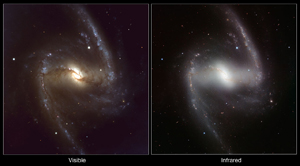Galaxies come in a lot of flavors. And even in the major categories (spiral, elliptical) there are sub-flavors… like barred spirals, which are truly cool and weird and awesome. Behold!
Yowza. Click to engalacticate.
That’s NGC 1365, a barred spiral about 60 million light years away in the Fornax cluster, as seen by the HAWK-1 camera on the Very Large Telescope in Chile. HAWK-1 is sensitive to infrared light, from just outside our human eye’s range to wavelengths about four times longer than we can see. Those wavelengths are pretty good (though not perfect) at penetrating dust clouds in galaxies, which block visible light. So mostly what you see in images like this one is light from stars, along with gas clouds. Where you see dark lanes is where the dust is so thick it blocks even the infrared light, too.
The two major spiral arms are obvious enough, as well as some smaller ones (called spurs) too. These are not physical spirals; stars near the center of the galaxy revolve faster around the center than ones farther out, and so if the arms were “real” they’d quickly (well, over a few hundred million years) wind up into a tight little curl. But we see spiral arms in galaxies of all ages, so we know they’re not transient, and must be stable features.
In the past few years the thinking is that the arms are traffic jams, literally regions where stars, gas, and dust pile up as they orbit the galaxy. Supporting this idea is that the arms are regions of intense star formation, which you’d expect if gas clouds are rear-ending each other in these jams. The clouds collapse after colliding and form stars. That also makes a lot of dust, and again you see a lot of that in the arms.
What causes the spiral pattern? That’s complicated and has to do with the way gravity works in a disk of star. Any sort of perturbation – the passing of a nearby galaxy, for example, or possibly even a wave of supernova explosions – can disturb the disk, causing the spirals to form.
 The same goes for bars. That’s the long, horizontal, relatively straight feature going across the galactic center. That’s a natural consequence of gravity in some galaxies, and in fact we are now pretty sure the Milky Way is a barred spiral, though our bar isn’t as prominent as the one in NGC 1365.
The same goes for bars. That’s the long, horizontal, relatively straight feature going across the galactic center. That’s a natural consequence of gravity in some galaxies, and in fact we are now pretty sure the Milky Way is a barred spiral, though our bar isn’t as prominent as the one in NGC 1365.
In the side-by-side image here (click it to get a much bigger picture), visible light from the galaxy is on the left and the IR image on the right. The dust is better at blocking visible light, so you can really see where the dust is… and once again, the bar is littered with it. Again, that makes sense since we’re seeing lots of star formation there.
Interestingly, the central bulge in NGC 1365 is elongated, and at an angle with respect to the bar. That bulge has mostly older, redder stars – that’s why it’s so prominent in the IR image. Those kinds of stars pour out infrared light. But it’s also lacking in dust and gas (the image is very smooth, indicating it’s the combined light of billions of stars; gas and dust would make it patchy like the bar and arms). That’s another indicator it’s old; all the gas has long ago been used up making stars.
It’s amazing what you can learn about a galaxy simply by comparing two images taken at different wavelengths. But that’s something astronomers have known for almost a century now; what we see with our eyes is not even close to the whole story, and it’s only by going outside our natural limitations that we can truly understand the Universe.
If there’s a morality lesson in that, I leave it to you to figure it out.
Tip o’ the dew shield to ESO_Observatory on Twitter. Images credit: ESO/P. Grosbøl
Related posts:
- Sculpting a barred galaxy
- Ten things you don’t know about the Milky Way galaxy
- Barred for life